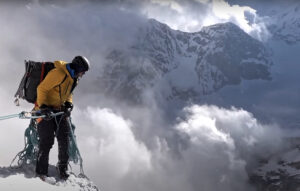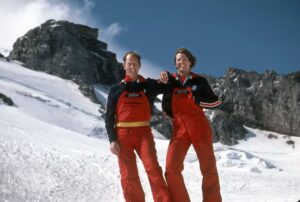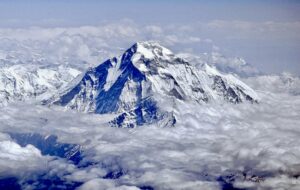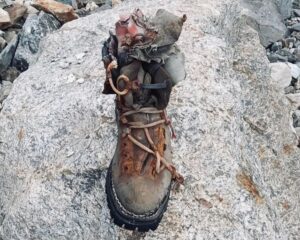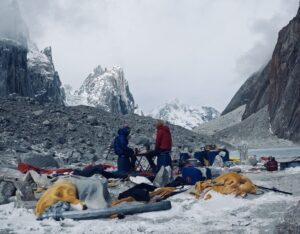Mount Haramosh was first noted in 1947 by a Swiss expedition, and in 1955 a German team investigated the northeastern route. But the Rakaposhi-Haramosh sub-mountain range, tucked away in the Karakorum, remained largely unknown with several major unscaled peaks. Intent to change this, the University of Oxford mountaineering club set out to climb Haramosh I in 1957.
The team
The team consisted of five climbers. Tony Streather was the expedition leader and oldest member of the team at 31. A professional soldier from the Royal Military Academy, Streather already had a long climbing résumé. He had been a member of the 1953 American K2 expedition, part of the team that completed the first ascent of Kangchenjunga in 1955, and was the first person ever to climb two peaks higher than 7,600m, amongst other achievements.

Tony Streather. Photo: Alchetron
The rest of the team were all in their 20s. Bernard Jillott was president of the Oxford University mountaineering club and had been the driving force behind the expedition. John Emery was Jillott’s climbing partner and a medical student. Rae Culbert was a Forestry student on a scholarship from New Zealand, and Scott Hamilton was a rock-climber on a scholarship from the US.
Arriving in Pakistan
At the end of July, the group reached Gilgit. Here they met their Hunza porters and headed for Haramosh. For a while, the team tried to access the mountain from the north and then west, but they eventually realized that these routes were impossible.

Kutwal Lake in the Haramosh valley, Pakistan. Photo: Explore Pakistan
They moved to Kutwal Valley and saw a long ridge to the northeast that would lead to the top of the mountain. To reach the top, the route passed first through Haramosh II, then it descended about 600m into a trough separating Haramosh II and Haramosh I. But the group could not see the distance well from below. The section from Haramosh II to Haramosh I was long, tedious, full of crevasses, and featured a dangerous glacier.
They started the route with great difficulty because of bad weather. It kept snowing and the slopes were overladen. The six Hunza porters helped carry food and gear to the camps. Three of them were expedition-hardened: Dhilap Shah, Rustam, and Shakoor Beg. The other three were younger and were keen to prove their worth, but they did not always trust the determination of the climbing team. The noise of nearby avalanches made them wary.

A large powder avalanche speeding down the west face of Haramosh II. Photo: Colin Wells
Slow progress to Camp 4
Access to Camp 1 and Camp 2 was difficult. Radio Pakistan was providing weather predictions for the next day to the team, but could not offer good news. The climbers had already been on the mountain for a month and a half, and they had little time left.
Hamilton stayed at Camp 3 and the porters descended to the lower camps. Emery and Culbert reached Camp 4 below Haramosh II, 300m below the crest of the northeast ridge. Jillott and Streather advanced a little further but then returned to Camp 4.

Diagram of the route from Base Camp. Photo: Ralph Barker
By September 15, Streather, Emery, Jillott, and Culbert were all in Camp 4. They woke up to good weather and at 11:00 am they began to ascend. Streather was the first to reach the crest. At the top, he was stunned by the beauty of the landscape and the fearful vastness that separated them from the peaks of Haramosh.
As Ralph Barker describes in his book The Last Blue Mountain: “The four men gazed spellbound, and none of them spoke for a long time.”

Rakaposhi, 7,788m, in the Rakaposhi-Haramosh subrange in Karakorum. Photo: Peakpx
They descended a few feet and sat down in a safe place, just before the slope became vertiginous. It was their last day and they wanted to make the most of it. Although they knew that they had no chance to complete the route, nor to crown Haramosh, they were very happy to have fulfilled their main objective, which was to explore the mountain.
Just a little higher…
Before descending, Jillott wanted to climb a little higher, towards a pinnacle, to better see their surroundings and the valley below them. He asked Emery to come with him.

Bernard Jillott and John Emery climbing up to the pinnacle. Photo: Tony Streather
Streather and Culbert stayed on the crest and took photographs. Suddenly there was a huge explosion. Everything happened in an instant. The snow under Jillott and Emery’s feet began to move and the two climbers, like dolls, slid down the slope. They fell into a snow basin 300 meters below.
When Streather looked over the abyss, he feared the worst. However, Jillott and Emery were alive and managed to unearth themselves from the avalanche debris. But they were trapped, surrounded by walls of ice and snow. During the fall they had both lost their ice axes. Jillott lost a glove, Emery lost both gloves, and had also suffered a hip dislocation.

Paul Nunn on Haramosh II. In 1995, he was one of the first summiters of Haramosh II. Unfortunately, he died during the descent. Photo: Colin Wells
Streather and Culbert threw a backpack with warm clothing at them, but the backpack fell into a different crevice. Jillott and Emery tried to climb up but couldn’t. They embraced for the night in a terrible bivouac at the bottom of the snow basin.
Streather and Culbert decided their only option was to try and climb down to the stricken climbers. The descent was very dangerous. It was practically vertical but they were able to descend slowly. In one very dangerous area, the slope became convex and they had to do a traverse to continue.
From bad to worse
The situation only got worse. Culbert lost one of his crampons. The two rescuers were suddenly in a very difficult situation.

Haramosh I, 7,409m. Haramosh I and its subsidiary peak Haramosh II are separated by a very difficult traverse. Photo: Fareed Gujjar
Finally, in the late afternoon, the two men made it to Jillott and Emery. But in the process, Streather lost his ice ax. The reunion was emotional but they weren’t yet out of the woods.
The four tied up and began to climb up out of the basin. It was their only escape route. At one point, Culbert, having only one crampon, slipped and fell, dragging the other three with him. They were once again at the bottom of the snow basin.

The climbers trying to get out of the snow basin. Photo: A screencap from the film He Who Dares – The Last Blue Mountain
A deadly descent
On their next attempt, everything was going well. Streather, who was leading, reached the beginning of the traverse. Suddenly, Jillott slipped. Once again, the four fell to the bottom of the snow basin. The group had now run out of ice axes, and night fell.
Some of the group began to suffer from frostbite. Culbert’s was particularly bad, Emery already had frostbite on his hand, and Jillott was delirious. The four embraced under the frozen sky.
Early the next morning they tried again. They had not eaten or drunk for two days. Streather decided this time was better without the rope. Emery, who was leading, managed to retrieve Streather’s ice ax from the wall and they reached the traverse, the most critical stretch. They only needed to descend a little, and then could continue down to the lower camps.
Emery and Streather made it, but Culbert had a major handicap, climbing with just one crampon. Streather climbed back up to Culbert to help him with the rope. But Culbert slipped and, taking Streather with him, slid back into the snow basin.
Roles reversed
Now, the rescuers and casualties had switched places. But Emery and Jillott were very sick, dehydrated, and had frozen hands. They were in no position to mount a rescue. Streather and Culbert had survived the fall but night fell again.
Emery and Jillott set off for Camp 4. They knew they had to get there, where there was food and drink, before heading back to the basin to try to rescue Streather and Culbert. Jillott staggered ahead but Emery, delirious, struggled to keep up.

Malubiting Peak 7,458m. Another peak in the Rakaposhi-Haramosh sub-range. First ascended in 1959. Photo: Atif Saeed
Emery tried to follow in Jillott’s footsteps but fell into some kind of open crevasse. He was unconscious all night and awoke the next morning with dawn. He made his way out of the crevice and saw Jillott’s footsteps. He understood that Jillott must have also fallen into the crevice but had managed to get out. Emery fell back into the footsteps and trudged down. But the footsteps did not lead to Camp 4.
Into the void
The footsteps suddenly disappeared. With horror, Emery realized that Jillott had fallen almost 2,000m into the void. He yelled his name several times, but there was no response. Jillott was clearly dead.
Despite severe frostbite, Emery eventually made it to Camp 4 and collapsed. Meanwhile, Streather and Culbert had realized they could not endure another night. They tried to get out of the snow basin and Streather succeeded, but again Culbert fell, further damaging his hip. Culbert could barely move.
Streather had to continue to Camp 4 alone, where he found Emery half-conscious. Streather learned of Jillott’s disappearance and went to the edge of the slope to call out Jillott’s name. He couldn’t believe that Jillott was dead.
They both wanted to go back to save Culbert. But they could not use their hands, they were dehydrated, and both had severe frostbite.

Haramosh I is south of Malubiting Peak. On this Google Earth capture, you can easily see the distance between Haramosh I and Haramosh II.
Tough decisions
Streather knew that he could only save Emery. He helped him descend to Camp 3, where they met Hamilton. Hamilton had first thought that his teammates had found a better route, but on the third day, his concern started to grow. He did not know what to do and could see nothing from Camp 3. He constantly prepared food and drink for his colleagues, who did not show up. It was a tremendous shock to him when he learned that Culbert and Jillott had died.
Hamilton took the two down to Camp 1, where the porters helped evacuate the survivors from the mountain.
Haramosh I was first ascended the next year by an Austrian team. Haramosh II was first ascended in 1995 by a British party, but two members of the expedition died on descent.


